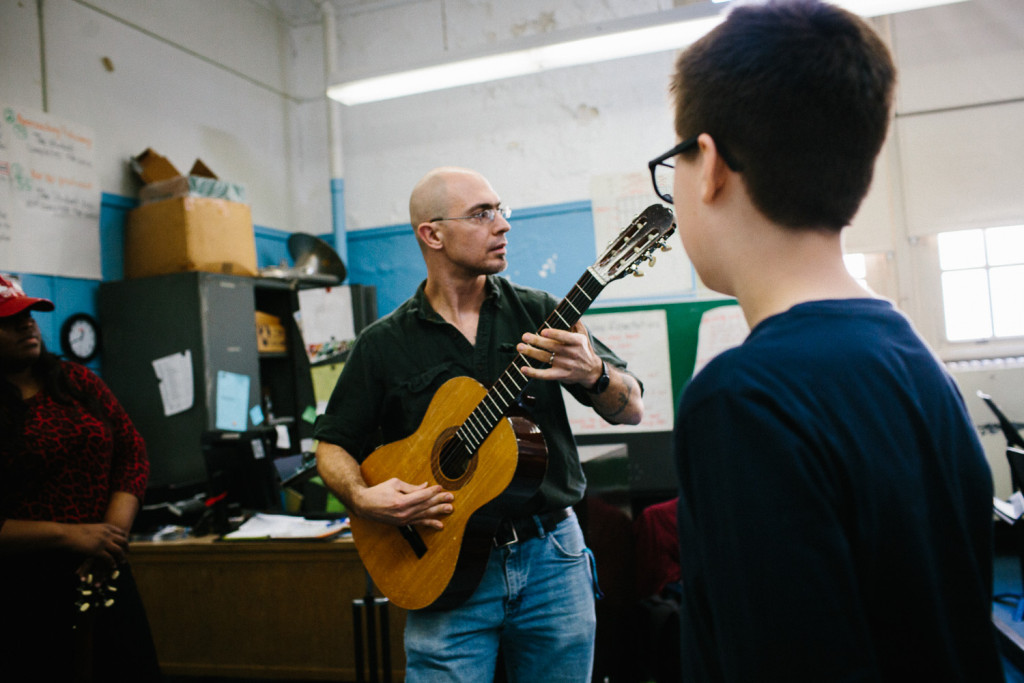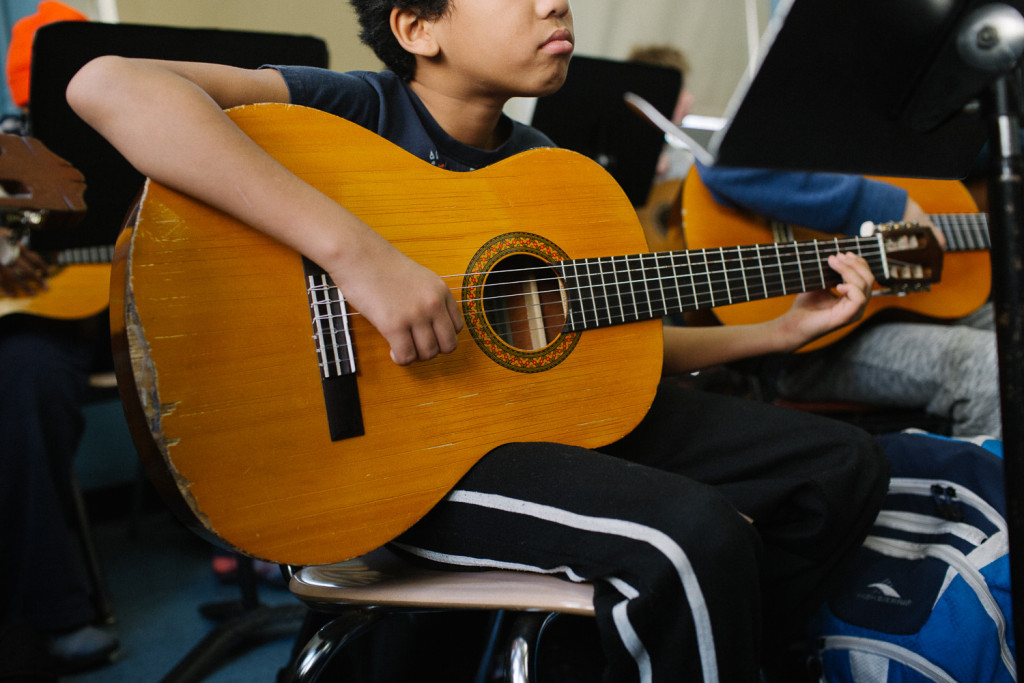
Scotch-taped to his desktop computer was a scrap piece of paper with the words “everyone you meet is fighting a hard battle.”
On a recent Wednesday afternoon, veteran music teacher Matt Gross, 41, of Park Slope Collegiate was taking his normal break between classes, restringing a guitar, preparing for the “discipline” session he was about to have with a 12-year-old.
The student he was about to see had stopped putting away her guitar after class, a routine that all his students had to follow. On the scale of problems, it was not a huge deal. But it did disrupt the class, and his workflow, and was, perhaps, a sign of something else going on. Gross glanced through some of the training materials from the new method of school discipline he and his colleagues had been practicing at Park Slope Collegiate for the last four school years.
It’s called collaborative problem solving. The idea is for adults and kids to work together to get to the bottom of the unwanted behavior and help learn how to change course. Teaching thinking and behavior skills is at the core—building relationships and not doling out punishments.
Gross bounded out of the classroom to retrieve the student from another class, glancing at the watch on his tattooed arm. He had 15 minutes. The young girl followed him back to the music room, her head bowed, expecting the worst. She’d never been through one of these “Plan B” meetings before. Gross had logged in more than 100 hours of them.
“Plan B,” a term coined by Think:Kids, is central to the collaborative problem solving model, used to describe the process by which adults and kids can work together to solve behavioral problems in what resembles a relationship building exercise.
After thanking her for coming, Gross launched into the issue:
“Something is different about cleanup,” Gross said. “Can you tell me why?”
“I don’t know, I just didn’t want to put the guitar in the bag,” she said, looking sullen.
“Were you upset with me and then didn’t want to cleanup?” he asked.
Gross was met with a long silence and a withering stare. “My plan has nothing to do with getting you in trouble,” said Gross, trying to reassure her. “I just want to get to the bottom of the problem and figure out how we can get to cleanup.”
She admitted she was mad at him, yes.
“And you were mad because I moved your seat,” said Gross. The next step was to come to a mutual solution. “Ok, I can understand. What can we do to avoid that?”
“Nothing,” the girl replied, obstinately.
“What if you stayed in one seat?” Gross tried again.
The seat issue was a sore subject between the teacher and student for a few weeks now. In class, the girl was accustomed to sitting with her two best friends who also had a history of not following directions or participating in class. Gross’ temporary solution had been to separate the three in order to get through the 50 minute class.
“How would you feel if your teacher separated you from your friends and made you sit all by yourself?” the 12-year-old had asked aloud to herself the week following her first Plan B meeting.
When Gross had brought up seating arrangements during their meeting, he was met with more silence.
“You seem pretty upset,” he observed out loud.
“Because I didn’t want to leave my class!” the girl exclaimed.
“Thanks for coming I’m sorry I took you out of class,” Gross replied, but before he could finish his sentence, the girl rushed out the door on her way to 6th period.
At first blush, this encounter did not appear to go well. But Gross’s behavioral interventions are often trial and error, with continual discussions that bear repeating. Gross reported that the following week in class, the seventh grader arrived less angry and more willing to follow directions. Plan B seemed to work.
Schools across the city are in the midst of adjusting to new city policy changes in school discipline that aim to reduce the use of suspensions in favor of alternative methods like restorative justice, peer counseling, or collaborative problem solving.
Park Slope Collegiate is one of a handful of city schools that has adopted collaborative problem solving, this unique empathy-based approach to discipline introduced in professional development sessions by the Department of Education.
Developed by Massachusetts General Hospital psychiatrists, the theory promotes the idea that kids with behavioral troubles lack the skill and not the will to behave well. Specifically, kids need to learn problem-solving skills, such as flexibility and frustration tolerance.
The approach is slowly growing in popularity ever since Mayor Bill De Blasio’s administration recommended in a school safety and discipline proposal last year that this collaborative problem solving the method be implemented as a “rule” and “not just a practice.”
The method is in stark contrast to the way discipline is generally understood. Unlike traditional models of discipline that hinge on penalty or obedience, this approach focuses on building relationships and skill building to help at-risk youth succeed in the school setting.
As a result, Park Slope Collegiate is in the middle of building a bottom-up code switch, where educators are not only rethinking zero-tolerance school discipline policies like suspensions, but demystifying the concept of the “misbehaved,” or “bad” kid all together.
In March the Education Department announced that suspensions fell nearly 32 percent from July to December 2015 as a result of de Blasio’s school-discipline reform. While the dramatic drop has been lauded, many educators still struggle to adapt to alternatives. Park Slope Collegiate however, is one school on the road to finding new solutions.
According to New York State data records, Park Slope Collegiate had a 23 percent suspension rate in the 2010-11 school year, the year before the principal and staff first encountered the collaborative problem solving approach. Recent school data shows that in fact suspensions at PSC have decreased to about four percent which the school credits to their rethinking of zero-tolerance discipline practices and initiatives like the Think:Kids model.
“Children do well if they can.”
This relatively new behavioral intervention was first developed in 2002 by Massachusetts General Hospital psychiatrists Dr. Ross Greene and Dr. Stuart Ablon who later went on to organize the non-profit research organization Think:Kids.
“Kids do well if they can,” Dr. Ablon said at a TedxBeaconStreet speaking event in Boston in 2014. He went on to explain how adults feel that their child needs to be compliant in order to be considered well behaved. “Compliant” children have no problem whatsoever following orders and doing tasks on demand, but Ablon explains this as being an unrealistic standard to hold all children accountable for.
The Think:Kids model requires the adult to identify both the adult’s and the kid’s concerns about a specific problem at hand so that both parties can brainstorm mutually beneficial solutions inside the classroom. It’s different from another discipline innovation, restorative justice, which focuses on rehabilitating troubled students with their school community,
According to Ablon, any child who falls outside the category of the “compliant” child is considered a challenging student by most adult standards. Most likely, as he details, these “non-compliant” children simply lack the skills to cope with frustrations.
Ablon believes that the lack of behavioral skills constitutes a learning disability and just like any other disability, it can be overcome with proper training.
“Where there’s a skill there’s a way,” said Dr. Ablon.
The neurologically-grounded model is not automatically understood, which is where the training by psychiatrists comes in.
“When I first went to one of these trainings I found myself welling up and wanting to hug Dr. Ablon,” Gross remembered of his first official training in the summer of 2012.
How does a guitar teacher become a school discipline aficionado?
A native of Park Slope, the Brooklyn school where he now teaches has been Gross’s second home for over ten years, back when it was still called the New School for Research. Before this collaborative approach entered Matthew Gross’ teaching life, he was a self-dubbed disciplinarian in the classroom. Gross regularly played by the discipline code of conduct, responding to disruptive behavior with punishment and or rewards.
“Carrots are better than sticks, was the philosophy when I first started teaching,” he said.
Something changed at the school when new principal Jill Bloomberg stepped onto the scene in July 2004. Her dedication to turning the once struggling school around grabbed the attention of long-time teachers like Gross who credit Bloomberg for the school community’s change of attitude toward student behavior.
Since Bloomberg was introduced to the collaborative approach in 2012, she has since made the practice’s language explicit in the school’s lexicon, helping to alter stressed teacher’s perceptions of difficult kids. Dr. Stuart Ablon’s famous words, “kids do well if they can,” suddenly became a phrase heard in variation all over the school.
Motivated by the new method and encouraged by Bloomberg, Gross stepped in as the in-house guru of the practice, hosting annual study groups for teachers interested in the approach and mediating meetings between fellow staff and their students.
Dr. Larry Epstein, a director of training and implementation at Think:Kids, became Park Slope Collegiate’s consultant. He worked with the school for the better part of a year as they were troubleshooting some of the first Plan B meetings with students. On the phone, Bloomberg and Gross would play back recordings of difficult sessions as Epstein advised them.
Another teacher convert to the method is Julia Konrad, 24, who was drawn to the school by the principal’s mission statement on the website to combine social and emotional skills with academic ones. She knew she had made the right decision in the midst of her interview for the job. Bloomberg was called away to de-escalate a behavioral incident with a student. The principal returned with the high school girl who she asked to sit in on the interview and help field questions.
“Why do you want to be a teacher?” was the question Konrad recalled being asked by the student. She knew at that moment that this school was where she wanted to teach. She wanted a school where having good relationships with your students and school leadership were critical.
“We never talk about discipline in school,” said Konrad. “It’s always about teaching and growth and learning and meeting student’s needs.”
While proponents of traditional discipline practices may conclude that a school without punitive discipline must be chaotic or violent, recent department of education surveys show that 81 percent of PSC students feel safe in the hallways while 84 percent of students report that teachers notice when they are upset or having emotional difficulty.
The Battle for Dignity in Schools
“One of the ironies of school discipline is that it isn’t really needed for most kids in schools,” said Dr. Stuart Ablon. And that includes black and Latino youth who bear a disproportionate brunt of conventional school suspensions and expulsions.
Dr. Ablon rejects the belief that kids are unmotivated. As Ablon explains, it is not the children that are unmotivated, but the adults who are unwilling to find alternatives to get to the root cause of behavior.
He has noted a slow shift in New York City schools’ relationship to discipline beginning with schools like Park Slope Collegiate that have embraced a different perception of their students, thus making the school an ideal candidate for collaborative problem solving practices.
“What has shifted at PSC is that they have a different view of who these kids are so as a result, teachers are able to partner with their students and help them build those problem solving skills,” said Ablon.
Meanwhile, Ablon worries that the pace of change in the rest of the city’s schools may be too slow.
On the other hand, the NYPD is ahead of the game, with widespread training imminent. “This is a fantastic opportunity and yet the NYPD can’t really be expected to do collaborative problem solving well unless the school embraces it and they’re using it together,” said Ablon.
The Think:Kids founder is currently in the middle of finalizing a contract with the New York City Police Department to train all 5,000 or more school safety officers in this innovative practice.
Until more schools join this discipline code switch, teacher-leaders like Gross can only hope to set an example through their every day classroom management practices.

In guitar class, a boy kept his hoodie on, hunched over his guitar and pouting over the fact that Mr. Gross had taken away his cell phone for the remainder of class. His fellow classmates strummed on their guitar strings as he sat there fixated on the empty seat in front of him. The cacophony of badly tuned guitars was suddenly interrupted by the bang of the boy kicking down the music stand in front of him.
Gross walked over calmly and approached the boy to speak softly and calmly at his level. He knew the seventh grader could play the guitar really well, but he needed to figure out why the boy’s emotions were interfering with his ability to learn.
After demonstrating a few notes, and then explaining why he had to take the phone away, the student picked up his guitar again and began to play gleefully. Next Gross hopped over to the opposite side of the room to work with a girl struggling to figure out a chord change. Again he kneeled down to the girl’s level and demonstrated the pesky chord, giving her suggestions on the best finger placement. Placing the instrument back in her hands, he watched as she repeated instruction with laser focus on her finger movements until finally she hit the chord.
Gross smiled and clapped enthusiastically, pleased that the girl who had been prone to outburst when frustrated, took the struggle in stride.
“You see that, she just built a new neural pathway!” exclaimed an excited Gross.




I remember when I worked in the same school with Mathew Gross. I loved how he bent down to each child’s level when speaking to them.